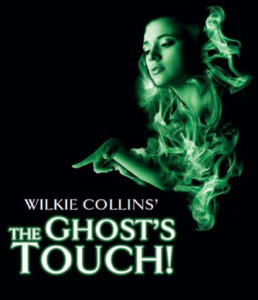
Mr Cholmondley-Warner Does the Twilight Zone
I’m preternaturally inclined to appreciate – even in just a lexical way – any kind of theatrical, literary or musical group or production that has an exclamation point in the name. Examples include Wham!, Panic! At The Disco, Oliver!, Moulin Rouge!, and now Wilkie Collins’ TheGhost’s Touch !, the latest production by Rumpus Theatre Company, who are no strangers to the Gothic given their past theatrical dalliances with the stories of HP Lovecraft, HG Wells, and Edgar Allan Poe to name but a few.
The Ghost’s Touch! was based on Mrs Zant and the Ghost, an early work by Wilkie Collins, a writer who would later be heralded as the pioneer of the literary detective in his seminal 1859 novel The Woman in White. The Ghost’s Touch! centres on a similar mystery and subsequent investigation; it begins as Stephen Rayburn (Mark Homer), a widower in Victorian England, goes for a stroll in Kensington Gardens with his young daughter, Lucy. However, a sunny summer’s day grows scary indeed when Lucy spots a ghostly figure in the woods talking to someone who remains invisible to characters and audience alike. The figure turns out to be Mrs Zant (Terri Dwyer), a (not the) woman in black caught in a daily loop of grief for her husband’s loss; a scene that she word-perfectly re- enacts seemingly to thin air every morning as though experiencing it for the first time. As Rayburn grows progressively attached to, and entangled in, the enigma of this other-worldly woman, he begins to question the very foundations of his beliefs, principles, and even his sanity.
This production was a pleasant surprise for me, a long-time theatre-goer but first-time horror show attendee. Possibly this is because I didn’t find the show quite as spine chilling as advertised – except for the very first instant when, before the curtain rose, the lights went out and a child’s voice whispered ‘Daddy’ over and over again, to disturbing effect. It was reminiscent of The Empty Child , that most disquieting of Doctor Who episodes, in which a creepy kid clad in a gas mask eerily enquires ‘Are you my mummy?’ However, that frightening first minute was the scariest part of the show by far. It was rather grating to move from that alarming audio experience to a scene where Rayburn calmly and amiably relates his trip to the park that day.
Although it wasn’t exactly chilling, The Ghost’s Touch! proved to be quite atmospheric at times. Mrs Zant is introduced illuminated with light in a dark stage, disappearing only to coalesce a little closer to Rayburn (and the audience) each time (although occasionally you could hear the footsteps of the actor shuffling from place to place, which downplayed the horror just a tad). An effective theremin- esque score nicely accentuates the more unsettling moments of the piece. However, the upbeat jolly hockey sticks fourth-wall-breaking delivery of the narrator was jarring at times when juxtaposed with the spooky set and spectral sightings. At times it was less Wilkie Collins’ The Ghost’s Touch ! and more Mr Cholmondley-Warner does the Twilight Zone.
One of the more unusual features of this production is that it takes minimalism to its limit, a totally understandable approach for a small theatre company to take, especially on tour. Luckily, the actors’ skill and the story’s intrigue maintained tension and interest from start to finish. The set was simple in the extreme – swathed in midnight-black material and featuring a sole park bench as the only prop in sight. The rest is left to lighting, sound effects and acting. The latter two were well done – the sound effects in particular were the unsung (and unseen) heroes of the piece – but the former was rather lacking overall; the lighting could have been used to more consistently convey a creeping sense of dread, and left a lot to the imagination, which was already working pretty hard to cope with the stripped-down cast and spartan set. Despite this, the staging and direction was at times extremely effective, in particular during some scene transitions towards the end of the play (to elaborate further would involve spoilers) where the lighting finally reared its creative head.
A two-hander through and through, the dynamic duo of Mark Homer and Terri Dwyer were the only physical presences onstage, with the other characters (including Lucy, Mrs Zant’s brother-in-law John, and various housekeepers, landladies and officers of the law) appearing in audio form only. The voice acting was very well done, with Lucy and John Zant (the latter voiced by John Goodrum, who doubled – tripled? – as the show’s writer and director) being the stand-outs. The scarcity of actors on stage, as well as a practical necessity on tour, actually plays well into the plot, keeping you healthily suspicious of whatever you see, hear and believe. Magical elements clash with the mundane, leaving the audience in the dark (both literally and metaphorically) as to the truth of our increasingly perplexed protagonist; much like Rayburn, the audience too is swept into uncertainty and indecision.
Rayburn is not only our protagonist, but our fourth-wall-breaking narrator, and an unreliable one at that. Mark Homer thrives in a deceptively tricky role, providing a genial, grounded counterpoint to the ghostly goings-on. John Goodrum did a good job in remaining faithful to the soul of the source material whilst reconstructing it into a theatrical narrative – and, in my opinion, vastly improving it by exploiting the original’s more ambiguous supernatural subtext into something more explicitly eerie. For example, Mrs Zant’s written account of her eerie experiences – letters and diary entries often featuring in Gothic novels of the era – is thankfully removed from this adaptation, remoulded instead into dialogue and inference, which works much better in a theatrical context. Terri Dwyer portrays a complex, haunting portrait of a woman who feels both realistic and mysterious, and her chemistry with Mark Homer is palpable, believable and carries the story right through to the final curtain. This adaptation also elegantly restores a sense of agency in her character that the novel lacks – her literary counterpart asks the only (living) man in her life to judge her sanity, whereas her theatrical self has complete faith in her beliefs and experiences (much to the surprise of the sceptical Rayburn).
However, the narration frequently conflicted with the air of mystery the play was going for, and none of Rayburn’s exposition was effective enough to justify its existence. The actors were very capably displaying the evolving emotions of the piece, and the rest of the information could have been outlined in the synopsis, or inferred from the action. But the themes – loss, grief, and the road to recovery – are beautifully expressed through the actors’ heart-breaking performances.
Doubles, metaphorical and manifest, permeate the plot; grief splits a person in two – who they were before the loss, and who they are now. Grief is a thing which duplicates as it grows, and each act of mourning is doubled, replicated, and reflected back at the mourner. This production doesn’t shy away from these concepts, and in its own way demonstrates that the only truly terrifying thing isn’t the thought of being confronted by a ghost, but by what the ghost represents – a loved one gone forever. To delve deeper into double-dom would take us into spoiler territory, and this is the kind of story you should experience with as little information as possible.
Stripped and unusual but interesting and enjoyable, Wilkie Collins’ The Ghost’s Touch! was a rather unique theatre experience that was ultimately anchored by Terri Dwyer and Mark Homer’s great performances. It embodies the stand-out quote from 2015’s Crimson Peak , Guillermo del Toro’s gory Gothic elegy: ‘it’s not a ghost story, it’s a story with ghosts in it’. If you like your dread creeping and your horror introspective, this is the show for you.

Barbara Hughes-Moore
Get The Chance has a firm but friendly comments policy.
